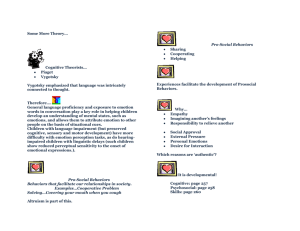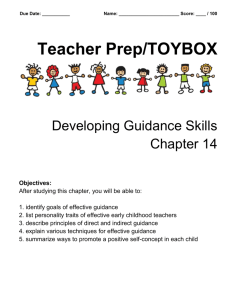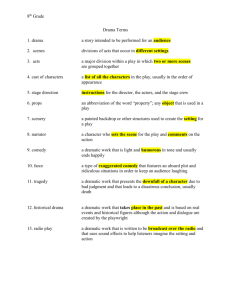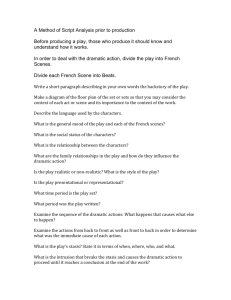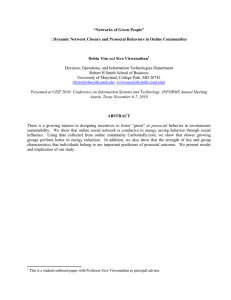Social Learning for the Preschool Child
advertisement
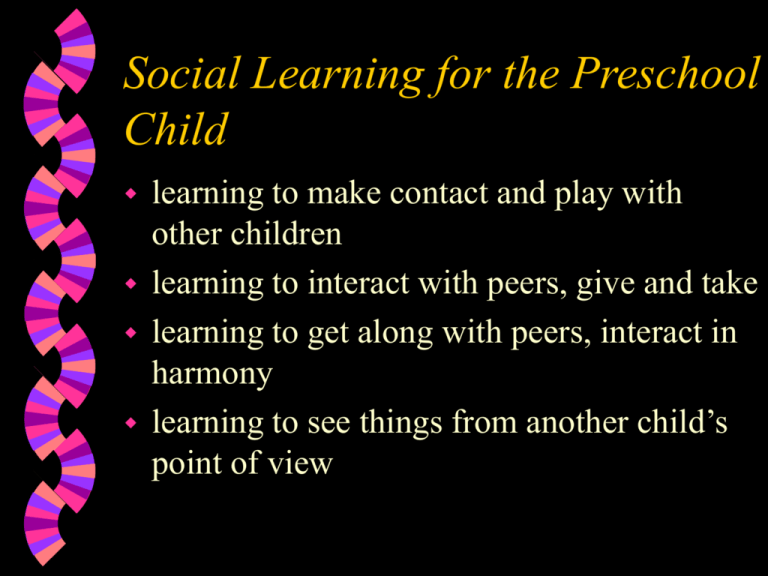
Social Learning for the Preschool Child learning to make contact and play with other children learning to interact with peers, give and take learning to get along with peers, interact in harmony learning to see things from another child’s point of view Social Learning for the Preschool Child learning to take turns, wait for a turn learning to share with others learning to show respect for others’ rights learning to resolve interpersonal conflicts Play is the primary mode for children’s social development. Play encourages social interaction. Children learn how to negotiate, resolve conflicts, solve problems, get along with each other, take turns, be patient, cooperate, and share. Play helps children understand concepts of fairness and competition. Parten’s Categories of Play unoccupied behavior onlooker behavior solitary independent play parallel activity associative play cooperative play Helping Children Develop Social Skills for Peer Acceptance Arrange classroom for small-group activities Observe and record social skills Help children initiate contacts with others Help children gain access to ongoing play Help children maintain play roles Help children learn to resolve conflicts Spends Time Watching Others Play Plays by Self with Own Toys/Materials Plays Parallel to Others with Similar Toys/Materials Plays with Others in Group Play Makes Friends with Other Children ECE Standards Debate Texas Essential Knowledge and Skills (TEKS) Teacher-Directed Instruction Didactic Methods of Instruction Developmentally Appropriate Practice (DAP) Child-Centered Learning Learning through doing processes Strategies to Gain Access to Ongoing Play Observing the group to see what is going on adopting the group’s frame of reference as in parallel play contributing something relevant to the play asking again if they can play Maintaining a Role in Ongoing Play Carry on a conversation maintain eye contact when speaking listen to and watch other speakers adjust own conversation content in order to be understood Learning through Group Dramatic Play Adjusting their actions to the requirements of their role and the group being tolerant of others and their needs not always expecting to have their own way making appropriate responses to others helping others and receiving help from them Sequence of Pretend Play Age 2 - can pretend & play with imaginary objects 2-4 years - complex group dramatic play with children who can articulate verbally 5 years - more complex dramatic play 6 years - group dramatic play declines 7 years - dramatic play disappears, games with rules more prominent Encouraging Dramatic Play in the Classroom Arrange class for small group activities Field trips/props Model play Puppets Change dramatic play area regularly Add accessories to block area Books Causes of Conflict Roles Direction of play Turns Toys Conflict Resolution Strategies ignoring distracting reasoning negotiating cooperating compromising Constructive Conflict Resolution Define problem Brainstorm possible solutions Use negotiation skills Choose solutions to satisfy both sides Helping Children Resolve Conflict observe and discuss play with you use puppets coach child on how to act do group role play books timers rhymes Prosocial/Moral Behavior Empathy Generosity Cooperation Caring Respect Responsibility Fairness Courage Honesty Empathy Shows concern for someone in distress Can tell how another feels Generosity Shares something with another Gives something to another Cooperation Takes turns without a fuss Complies with requests without a fuss Caregiving Helps another do a task Helps care for another in need Respect Uses please and thanks when making and receiving requests Treats others as would want to be treated Responsibility Corrects behavior when appropriate behavior is modeled Notices and redirects another child behaving inappropriately Fairness Takes turns, follows rules Listens to what others say Courage Does what is right even when the task is hard Honesty Tells truth Does what he/she says will do Focus on Prosocial Behaviors Value and emphasize consideration for others’ needs Model prosocial behaviors/Highlight in others Label and identify behaviors Attribute positive social behaviors to children themselves, people they know and historical figures Encourage understanding of feelings and perspectives Acknowledge and encourage understanding and expression of children’s feelings Facilitate perspective and role-taking skills and understanding others’ feelings Emphasize consequences of behavior Encourage Problem Solving for Prosocial Behaviors Identify the problem Gather information List and consider options Consider advantages and disadvantages Choose and try a solution Decide if the solution worked Encourage Prosocial Behavior Use questions Show Pictures Use children’s literature Using Children’s Literature in Moral Education Story should have a well-defined dilemna Characters should model levels of reasoning and decision-making close to the reasoning level of children in class Story should be appropriate for follow-up activities and extensions Quality of story should be high – powerful plot, lively characters, satisfying conclusions Story should promote critical thinking skills Characters should promote a wide range of physical, social, emotional features and clear representations of good and evil Leading Moral Discussions What happened in the story? Why do you say that? What did you learn from this story? Should we forgive [a character]? Why? Why was [a character’s behavior] unkind? What does this story remind you of in your own life? In what way? Do you agree with outcome? Why? Positive Discipline Protecting against media violence Alternatives to aggressive behaviors Choices Technology
